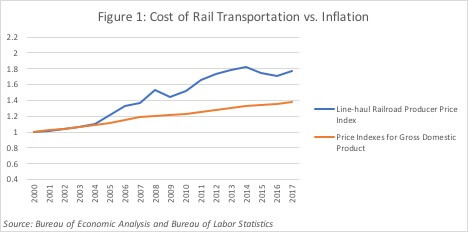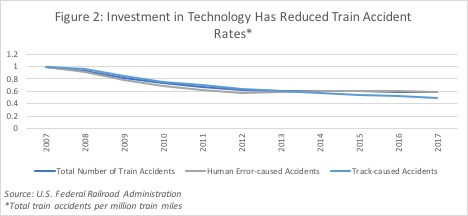The Progressive Policy Institute (PPI) has previously opposed arbitrary, redundant, and costly regulations, and proposed the Regulatory Improvement Commission to eliminate them. Regulation plays a vital role in refereeing market competition, protecting public health and safety, and keeping powerful economic actors honest. But regulations must be more nimble and adaptable to catalyze growth in a fast-changing world.
For people skeptical that regulation inhibits innovation and productivity growth, here’s an example of a wrong-headed proposed rule that would put Washington in the business of micromanaging employment in the freight rail sector.
When the Rail Safety Improvement Act was passed following the 2008 Chatsworth train collision, it mandated freight railroads implement Positive Train Control (PTC). PTC is a nationwide system of newly developed technologies that constantly processes thousands of variables to avert human error, including train collisions and derailments. Its implementation came at a hefty price to the railroads, estimated to cost more than $10 billion by completion.
One of the benefits of PTC was that it would enable railroads to move from two-person to one-person crews at some point down the road, boosting productivity with no loss of safety.
However, lawmakers now appear eager to flip course as fears of automation and job loss loom large in public policy conversations. Earlier this year, the Safe Freight Act was introduced in the Senate, a companion bill to a bipartisan House proposal unveiled in 2017. The legislation would mandate the crew size of freight trains to include both a locomotive engineer and a train conductor. While the legislation will not pass before midterms, it is likely to be reintroduced next Congress.
These proposals would deny freight rail the productivity gains of the digital age despite the widespread embrace of automation for passenger vehicles and commercial trucks on highways. Labor productivity for rail transportation has risen only a modest 16 percent over the last decade, about the same as the lagging pace of productivity growth across the entire U.S. economy. Meanwhile, as shown in Figure 1, the price of railroad transportation has risen 77 percent since 2000, far outpacing inflation. Allowing the freight rail industry to digitize would jumpstart productivity growth and cut distribution costs for the energy, manufacturing, and construction sectors they serve.

What’s more, there is no evidence to suggest that one-person crews are less safe than two-person crews. Single-person crews are commonly used in other countries and the FRA acknowledges the “evidence…indicates that safety record of these foreign operations are acceptable.” In the U.S., crew sizes have steadily been reduced from the five-person crews of the 1970s to the current two-person crews, with accident rates falling more than 80 percent during that time. And passenger trains have safely used single-person crews for decades.
Railroad investment and technological advances have played a critical role in realizing safety gains over the last decade. Since 2008, freight railroads have spent $245.3 billion on capital expenditures like infrastructure and equipment. Ultrasound, ground-penetrating radar, smart sensors, analytics software, and data sharing have enabled railroads to proactively identify and fix track and equipment issues. As a result, railroad accidents are at a historic low, according to data from the FRA. As shown in the figure below, the total train accident rate dropped 42 percent from 2007 to 2017. Track-caused accidents have dropped 51 percent. And accidents caused by human error are down 41 percent.

The implementation of PTC promises to further drop accident rates. According to forecasts from the Federal Highway Administration, total U.S. freight shipments will rise from 17.7 billion tons in 2016 to 24.2 billion tons in 2040, a 37 percent increase. Imposing crew size mandates on the freight rail industry would inefficiently divert resources from investing in safety, cutting costs for consumers, and improving and expanding America’s rail infrastructure. Rather, it would unnecessarily increase labor costs in the safest era ever of rail travel.